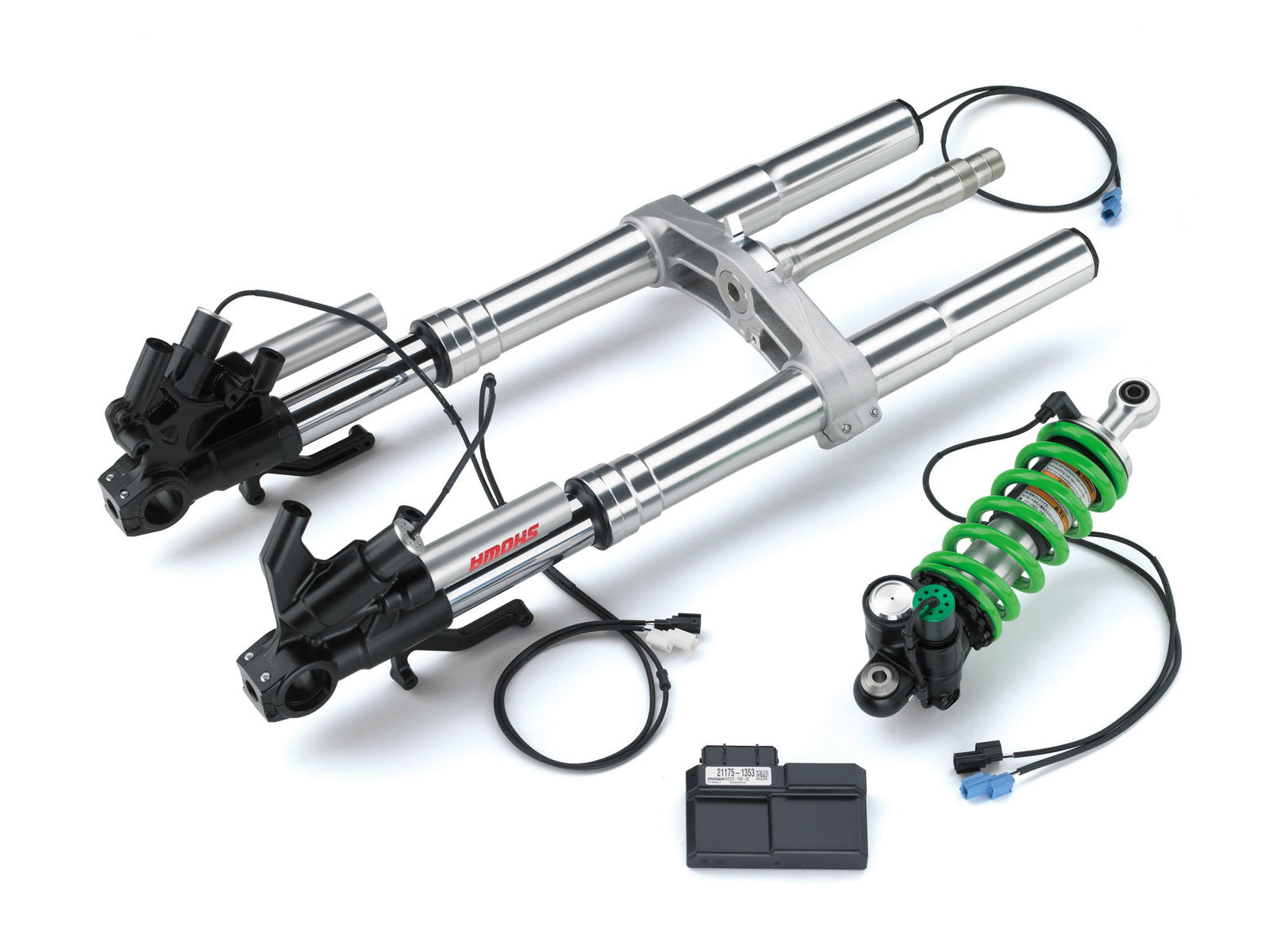Top tips for riding a motorbike in ice and snow
riding a motorcycle in ice and snow might not be advisable, but sometimes there isn't another option. Here's how to ride a bike in winter conditions safely

In the UK we really cannot avoid winter, and with the UK going through a cold snap right now, there may be some of you wondering just how you are going to get to work when there is ice and snow on the ground. If you really need to ride this winter and want to know how to ride a motorcycle in snow or ice as safely as possible, this article is for you!
You might also want to read this guide to preparing your motorcycle for winter, giving you all the information you need to keep your wheels turning smoothly when the warmer weather reappears.
For everything else, see below.
How to ride a motorcycle in snow
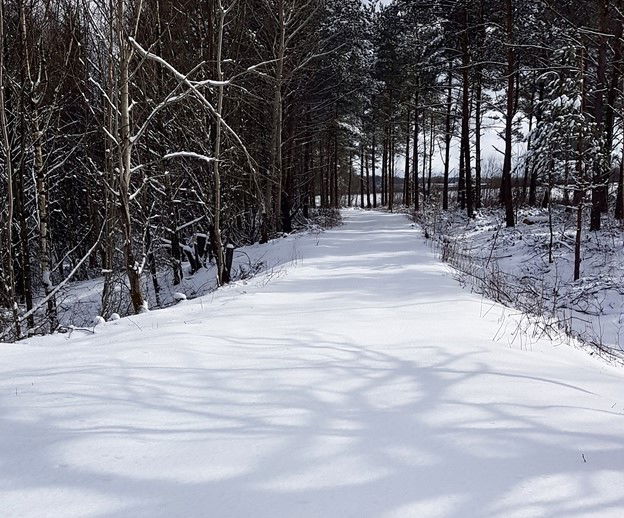
How do you ride in fresh snow?
Fresh snow can be best described as virgin snow and you'll know it as it will look like you are the first vehicle to travel along that stretch of road.
First off, this is actually one of the better types of snow to ride on, as long as you can see the sides of the road and any traffic furniture that is. The reason for this is that as you ride over the surface of the snow, it’ll get compacted under your tyres, filling the grooves within the tyre in the process. Moulding the snow in this way will provide slightly more grip on the surface than riding on already compacted snow. That's not to say it isn't without its perils though, an icy layer beneath snow can easily form, and if that is the case the going can still be treacherous.
As with any winter riding, keep the bike slow, and if you can trickle along just above tickover with the bike a gear or two higher than you would need if riding in the dry. In doing this you'll not be as close to the areas in the rev-range when peak torque and power appear, and with the bike in a gear or two higher than needed, the torque of the engine will already dulled enough that any small throttle inputs should be softened considerably.
It can be tempting to ride the clutch at times like this, but should you have a small handlebar wobble you risk releasing some pressure from the lever and introducing more power to the back wheel. It's best to get the bike in a gear you feel comfortable riding along in and then leave the clutch well along, until you need to change a gear or come to a stop.
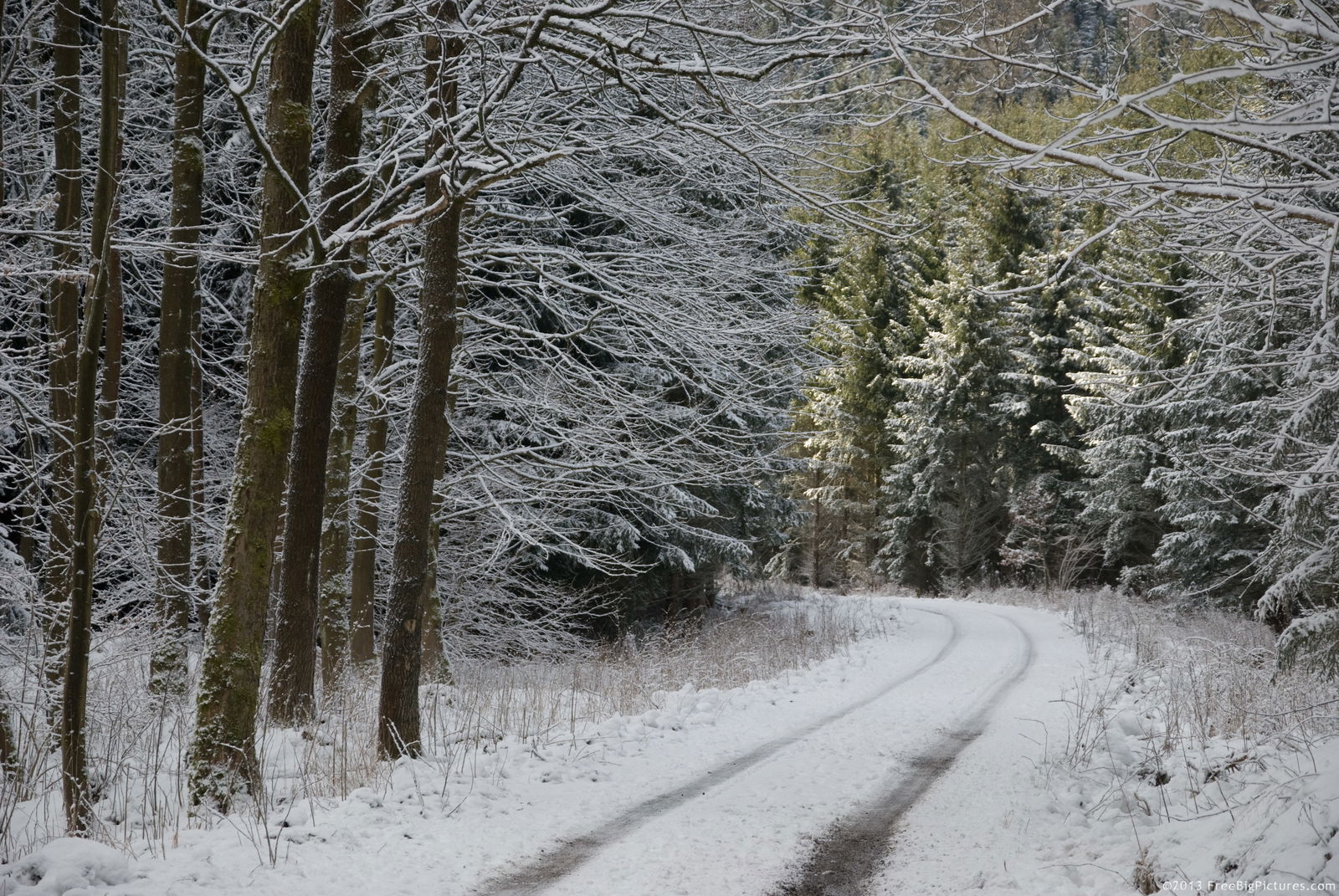
How do you ride on already compacted snow?
This could best be described as a snow-covered road that has already seen traffic. There are clearly defined tyre tracks where cars and traffic have driven.
When confronted with this, it can be too easy to head to the already driven tracks left by other vehicles but that might not be the best choice. The compacted snow in the tyre tracks can become polished and almost as slippery as sheet ice and once you are in a tyre track it may prove tricky to get out of it! If you can, make for the centre of the road and use the fresh snow in the middle. Just take extra care if you must cross over any tyre tracks at junctions and roundabouts.
The same rules regarding the gears and throttle inputs (mentioned above) apply when riding on compacted snow, but now there is a chance you'll be sliding much more so keep the speed even lower. The main thing to focus on now is the bike, where it is going and what it is doing beneath you. Like riding on very slippery clay and mud, you have to expect that the bike is going to slip and slide beneath you, but the best thing to do is stay relax and try not to tense up. There is always a desire to paddle along when the roads of icy and slippery, and while that might make you feel more secure, the chances are your riding boots don't have much more grip than the tyres do, and sometimes if 200kg of motorcycle is starting to slide away beneath you, the best thing you can actually do is just let it.
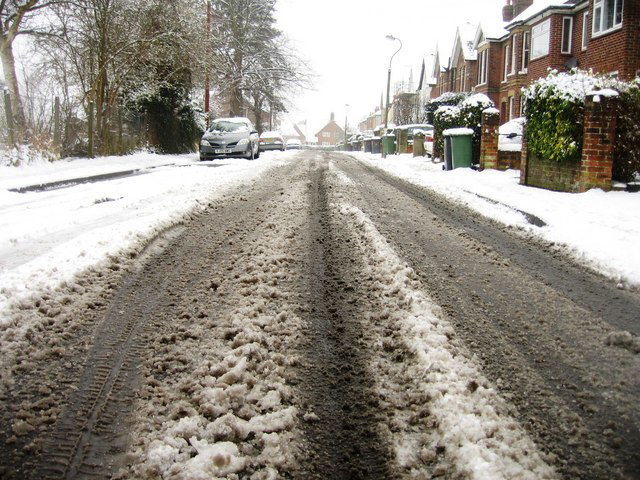
How do you ride a motorcycle in slush?
The gritters have now done their work and the bulk of the snow and ice is clearing. You’re now left with a slushy, wet and grey road to progress along. Riding on slush has one main advantage over compacted snow, as the bike’s tyres might be able to cut through the melted snow, contacting the road surface beneath. There is a negative through, any areas that didn’t feel the full force of the gritter could be hiding a motorcyclist’s winter nemesis – black ice. As with any other riding of this kind, proceed with caution!
As with riding in compacted snow, keeping the speed down and focusing on the road ahead are key to keeping safe here. Black ice is, as the name suggests, pretty much invisible on the road, and with droplets of water and salt crust on the outside of your visor, and probably some fogging on the inside of it, your chances of spotting it at anything above walking pace is basically nil! One thing that will help if you do hit some is your speed, keeping that low but still safe should have you skipping over all but the largest black ice patches before the tyres have even realised that they haven't got any grip anymore.
Picture: Sebastian Ballard
How to ride a motorcycle in snow | Top Tips
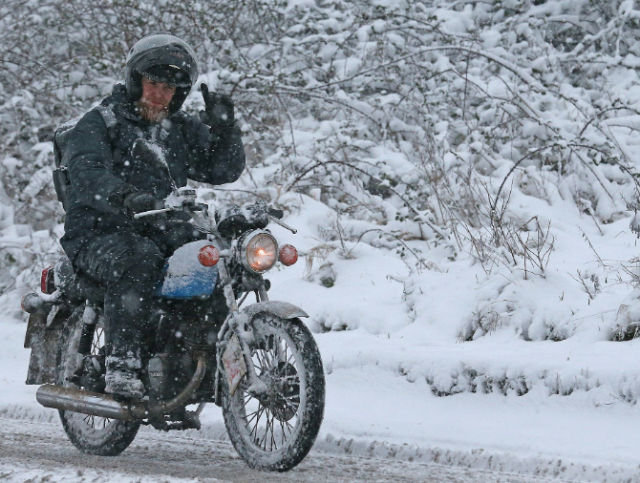
Get in the right gear!
Freezing to your core is never a nice feeling, it also makes your body tense and less able to accurately react to messages from your brain. Wear your warmest gloves, textiles, and boots. Zip the jacket and trousers together to prevent any draughts and layer up beneath them. A cheap set of thin woolly gloves under your winter riding gloves might seem like a good idea, but for this kind of riding, you need a deft touch. Heated gloves or grips (or both) are a much better option.
Head here to check out our guide to buying the best-heated motorcycle clothing.

Get in the correct gear!
No not clothing, your gearbox. For snow riding, you want to be in the highest gear you can possibly use at any given time. Doing this will suppress the power and torque of the engine and help prevent the bike from spinning up. If you can, try pulling away in second gear using low revs and slipping the clutch. The main thing to try and remember though is to keep the revs of the bike low and any inputs on any of the controls soft and controlled. You don't want to be stabbing the throttle or grabbing the brakes when the weather is cold and snowy.
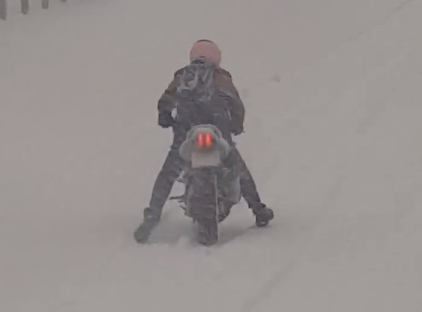
Take a seat
When riding off road and in mud, it’s best to be standing on a bike, not so much on snow. Keeping seated means your legs can easily and quickly come to your aid should you need them – and the chances are you will at some point
Loosen up
It’s hard to relax when riding in snow as it’s such a precarious situation but being tense will only make it worse. Loosen your shoulders and keep a bend in your elbows. It’s easier said than done but makes a big difference to the amount of control you have.

Know where you’re going
Last-minute changes of direction are not advisable when riding on any kind of snow. Know your route and take your time. If you miss your turn, you’re better off riding around the block than trying a U-turn.
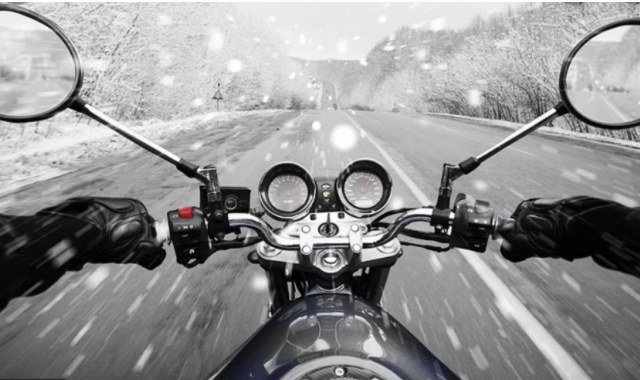
Don’t mix it up
Riding a motorcycle in the dry is a complex thing to do, it’s just that after practising for so long, your brain converts it all into precise and well-balanced reflex actions. Riding in snow is different, you don’t want to react to things, you want smooth, controlled actions. Plan for the road you can see ahead of you. When a corner approaches, slow the bike gently while in a straight line using plenty of engine braking. Take the corner slowly and don’t be scared to trail one or both legs at your side. Only when the bike is out of the corner and in an upright position should you begin to increase speed again – not forgetting the rule about high gears!
Any amount of braking pressure applied with even the slightest amount of lean angle could result in you dropping it. The same goes for acceleration. Opening the throttle with lean on the bike – even with the trickest traction control (which is generally calibrated for normal wet or dry conditions) – could result in the rear spinning up and sliding out from under you.
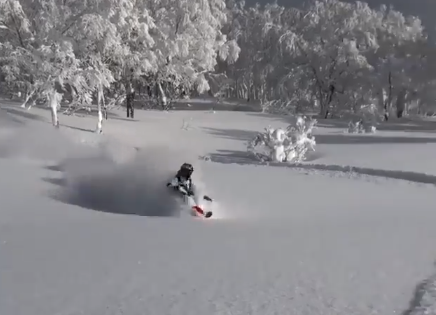
A Quickshifter might not be the best option
If your bike has a quickshifter, it is advised to clutch-shift normally when riding in the snow. The act of feeding the power back in on the clutch is smooth and will upset the bike and the tyres much less than a quickshifter’s mechanical brutality.
Everything takes longer in snow
Stopping, accelerating and cornering will all have to be approached in a slower, calmer and more measured way. If following another vehicle, keep at least double the distance further back than you would in the wet. And begin braking twice as early as you normally would.
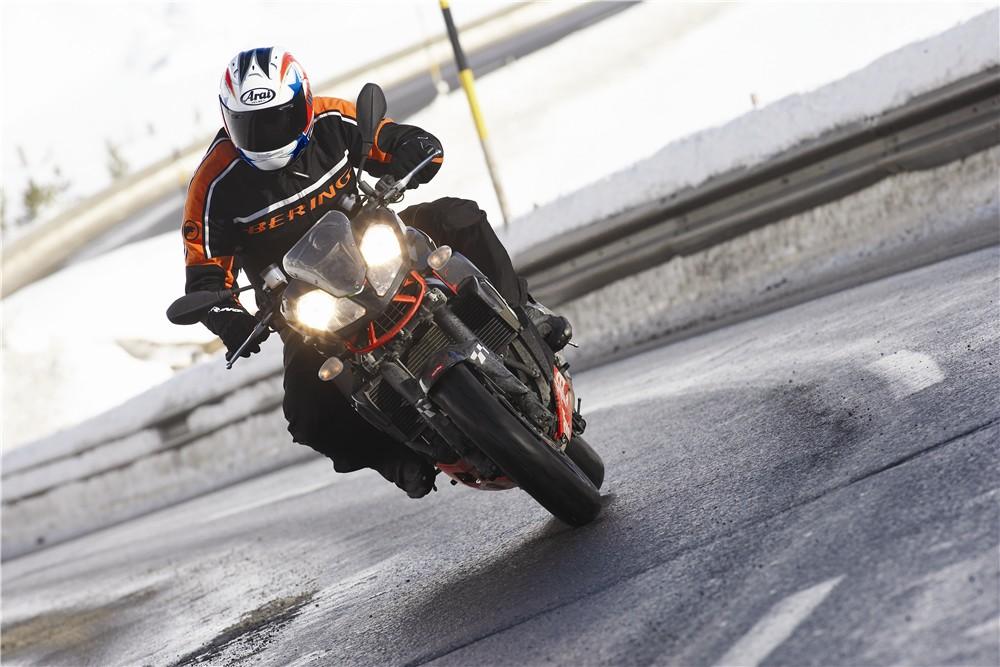
Keep your visor clear
Don’t make the act of riding in the snow any harder than it needs to be! Keep your visor clear and free of mist and snow. Invest in a breath guard and fit the correct Pinlock for your lid. Keep your bonce warm too, a thin balaclava under your lid will help keep the winter chills at bay and will aid concentration.

Leave the Supercorsas in the garage
They won't heat up, they won't clear snow and they won't provide much more grip than a slick! Some decent adventure bike tyres or even deeply grooved and fairly new touring hoops will be 100% more suitable.
Check out our complete guide to getting your bike ready for winter here.
Be bright
Hi-vis isn’t cool or sexy, but in a snowstorm, it will massively increase your chances of being spotted by another road user. Even some reflective stickers on your lid are better than nothing. The other vehicles on the road will take longer to stop, let’s give them more chance of spotting us so they can start braking earlier.
So, there you have it, Visordown's complete guide on how to ride a motorcycle in snow and icy conditions. Remember, you should only ride in the snow if you have absolutely no other option, unless you have a fancy pants enduro bike and it can actually be quite good fun!
![Scott Redding - Be Wiser Ducati, 2019 BSB [credit: Ian Hopgood]](https://cdn.visordown.com/field/image/IMG_6912.JPG?width=1600)
